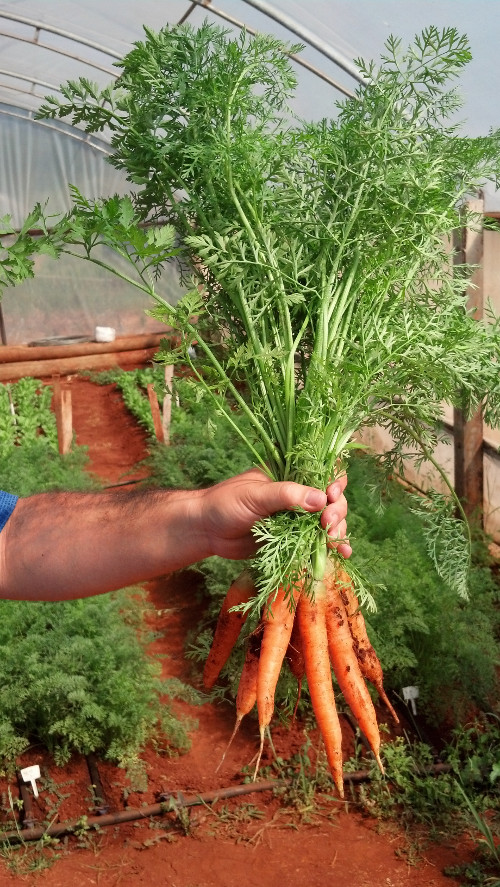Magnetically treated water for irrigation: effects on production and efficiency of water use in carrot (Daucus carota L.) crop

Abstract
Carrot cultivation has increased within vegetable production because of its benefits to human health. The aim of this study was to investigate the effect of different irrigation using magnetically treated water and potable water on a carrot crop. The experiment was conducted in the Department of Rural Engineering of the Faculty of Agricultural Sciences (FCA-UNESP), Botucatu-SP Campus (Brazil), from September to December, 2015. A randomized complete block with a 2×5 factorial and 10 repetitions was adopted. Thus, the treatments included 2 types of water (potable and magnetically treated) and 5 spare blades that corresponded to the percentage of evapotranspiration (25, 50, 75, 100 and 125% ETc), with drip irrigation. The magnetically treated water irrigation yielded an increase in green root biomass, and the highest production was seen with 100 and 125% ETc, verifying the possibility of increased carrot productivity. There was a significant increase in the number of leaves, bulb length and diameter when the carrot crop was irrigated with magnetically treated water.
Keywords
Drip Irrigation, magnetism, tubers, water management, productivity, harvest quality
References
- Aladjadjiyan, A. e T. Ylieva. 2003. Influence of stationary magnetic field on the early stages of the development of tobacco seeds. J. Central Eur. Agric. 4(2), 1-8. Doi: 10.5513/jcea.v4i2.167
- Allen, R.G., L.S. Pereira, D. Raes e M. Smith. 1998. Crop evapotranspiration-guidelines for computing crop water requirements. FAO Irrigation and Drainage Paper 56. FAO, Roma.
- Banzatto, D.A. e S.N. Kronka. 2006. Agricultural experimentation. Fundação de Apoio a Pesquisa, Ensino e Extensão, Jaboticabal-SP, Brasil.
- Carvalho, R., A.E. Furtine Neto, C. Nilton e L.A. Fernandes. 2000. Dessorção de fósforo por silício em solos ácidos. Rev. Bras. Ciênc. Solo 24, 69-74. Doi: 10.1590/S0100-06832000000100009
- Grewal, H.S. e B.L. Maheshwari. 2011. Magnetic treatment of irrigation water and snow pea and chickpea seeds enhances early growth and nutrient contents of seedlings. Bioelectromagnetics 32(1), 58-65. Doi: 10.1002/bem.20615
- Lima Junior, J.A., G.M. Pereira, L.O. Geisenhoff, W.G. da Silva, R.C.V. Boas e R.J. Souza. 2012. Desempenho de cultivares de cenoura em função da água no solo. Rev. Bras. Eng. Agríc. Ambient. 16(5), 514-520. Doi: 10.1590/S1415-43662012000500007
- Khoshravesh, M., B. Mostafazadeh-Fard, S.F. Mousavi e A.R. Kiani. 2011. Effects of magnetized water on the distribution pattern of soil water with respect to time in trickle irrigation. Soil Use Manage. 27, 515-522. Doi: 10.1111/j.1475-2743.2011.00358.x
- Köppen, W. e R. Geiger 1928. Klimate der Erde. Verlag Justus Perthes, Gotha, Alemanha.
- Lin, I.J. e J. Yotvat. 1990. Exposure of irrigation and drinking water to a magnetic field with controlled power and direction. J. Mag. Mag. Mat. 83(1), 525-526. Doi: 10.1016/0304-8853(90)90611-S
- Maheshwari, B.L. e H.S. Grewal. 2009. Magnetic treatment of irrigation water: its effects on vegetable crop yield and water productivity. Agric. Water Manag. 96, 1229-1236. Doi: 10.1016/j.agwat.2009.03.016
- Mohamed, A.I. 2013. Effects of magnetized low quality water on some soil properties and plant growth. Int. J. Res. Chem. Environ. 3(2), 140-147.
- Marouelli, W.A., W.L. Silva e C.L. Moretti. 2002. Desenvolvimento de plantas, produção e qualidade de bulbos de alho sob condições de deficiência de água no solo. Hortic. Bras. 20(3), 470-473. Doi: 10.1590/S0102-05362002000300014
- Putti, F.F., L.R.A. Gabriel Filho, A.E. Klar, C.P. Cremasco, R. Ludwig e J.F. Silva Junior. 2013. Desenvolvimento inicial da alface (Lactuca sativa L.) irrigada com água magnetizada. Rev. Cultivando o Saber 6(3), 83-90.
- Putti, F.F., L.R.A. Gabriel Filho, A.E. Klar, J.F. Silva Junior, C.P. Cremasco e R. Ludwig. 2015 Response of lettuce crop to magnetically treated irrigation water and different irrigation depths. Afr. J. Agr. Res. 10(22), 2300-2308. Doi: 10.5897/AJAR2015.9616
- Rawabdeh, H., S. Shiyab e R. Shibl. 2014. The effect of irrigation by magnetically water on chlorophyll and macroelements uptake of pepper (Capsicum annuum L.). Jordan J. Biol. Sci. 10(2), 205-21.
- Sayed, H. e A. El Sayed, 2014. Impact of magnetic water irrigation for improve the growth, chemical composition and yield production of broad bean (Vicia faba L.) plant. Am. J. Exp. Agric. 4(4), 476-496. Doi: 10.9734/AJEA/2014/7468
- Selim, A.F.H. e M.F. El-Nady. 2011. Physio-anatomical responses of drought stressed tomato plants to magnetic field. Acta Astronaut. 69(7), 387-396. Doi: 10.1016/j.actaastro.2011.05.025
- Shibairo, S.I., M.K. Upadhyaya e P.M.A. Toivonen. 2002. Changes in water potential, osmotic potential, and tissue electrolyte leakage during mass loss in carrots stored under different conditions. Sci. Hortic. 95, 13-21. Doi: 10.1016/S0304-4238(02)00034-1
- Silva, V.J., R.E.F. Teodoro, C.H. Paula, A.D. Martins e J.M.Q. Luz. 2011. Response of the application of carrot different irrigation. Biosci. J. 27(6), 954-963.
- Snyder, R.L. 1992. Equation for evaporation pan to evapotranspiration conversions. J. Irrig. Drain. Eng. 118(6), 977-980. Doi: 10.1061/(ASCE)0733-9437(1992)118:6(977)
- Souza, E.R., A.A. de A. Montenegro, S.M.G. Montenegro e J.A. de Matos. 2011. Temporal stability of soil moisture in irrigated carrot crops in Northeast Brazil. Agric. Water Manag. 99, 26-32. Doi: 10.1016/j.agwat.2011.08.002
- Taiz, L. e E. Zeiger. 2013. Elementi di fisiologia vegetale. Piccin-Nuova Libraria, Pádua, Itália.
- Ul Haq, Z., M. Iqbal, Y. Jamil, H. Anwar, A. Younis, M. Arif, Z. Fareed e F. Hussain. 2016. Magnetically treated water irrigation effect on turnip seed germination, seedling growth and enzymatic activities. Inf. Proces. Agric. 3(2), 99-106. Doi: 10.1016/j.inpa.2016.03.004
- Zhou, K.X., G.W. Lu, Q.C. Zhou, J.H. Song, S.T. Jiang e H.R. Xia. 2000. Monte Carlo simulation of liquid water in a magnetic field. J. Appl. Phys. 89, 1802-1805. Doi: 10.1063/1.1305324
